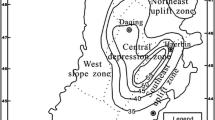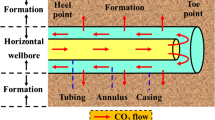Abstract
Underground non-Darcy fluid flow has been observed and investigated for decades in the petroleum industry. It is deduced by analogy that the fluid flow in enhanced geothermal system (EGS) heat reservoirs may also be in the non-Darcy regime under some conditions. In this paper, a transient 3D model was presented, taking into consideration the non-Darcy fluid flow in EGS heat reservoirs, to simulate the EGS long-term heat extraction process. Then, the non-Darcy flow behavior in water- and supercritical CO2 (SCCO2)-based EGSs was simulated and discussed. It is found that non-Darcy effects decrease the mass flow rate of the fluid injected and reduce the heat extraction rate of EGS as a flow resistance in addition to the Darcy resistance which is imposed to the seepage flow in EGS heat reservoirs. Compared with the water-EGS, the SCCO2-EGS are more prone to experiencing much stronger non-Darcy flow due to the much larger mobility of the SCCO2. The non-Darcy flow in SCCO2- EGSs may thus greatly reduce their heat extraction performance. Further, a criterion was analyzed and proposed to judge the onset of the non-Darcy flow in EGS heat reservoirs. The fluid flow rate and the initial thermal state of the reservoir were taken and the characteristic Forchheimer number of an EGS was calculated. If the calculated Forchheimer number is larger than 0.2, the fluid flow in EGS heat reservoirs experiences non-negligible non-Darcy flow characteristic.
Similar content being viewed by others
Abbreviations
- A :
-
Area/m2
- c p :
-
Specific heat capacity/(J·kg−1·K−1)
- Fo :
-
Forchheimer number
- Fo ch :
-
Characteristic Forchheimer number
- g :
-
Acceleration of gravity/(m·s−2)
- ha :
-
Volumetric heat exchange coefficient/(W·m−3·K−1)
- k :
-
Thermal conductivity/(W·m−1·K−1)
- K :
-
Permeability/m2
- p :
-
Pressure/Pa
- Q :
-
Mass flow rate/(kg·s−1)
- Re :
-
Reynolds number
- t :
-
Time/s
- S ND :
-
Non-Darcy term
- T :
-
Temperature/K
- T g :
-
Ground temperature/K
- u :
-
Velocity vector/(m·s−1)
- x, y, z :
-
Cartesian coordinates
- ρ :
-
Density/(kg·m−3)
- ε :
-
Porosity
- μ :
-
Dynamic viscosity/(Pa·s)
- β :
-
Non-Darcy coefficient
- γ :
-
Relative velocity reduction
- ch:
-
Characteristic
- eff:
-
Effective
- f:
-
Fluid
- H2O:
-
Water
- inj:
-
Injection
- ini:
-
Initial
- out:
-
Production, outlet
- ref:
-
Reference
- s:
-
Solid or rock
- SCCO2 :
-
Supercritical carbon dioxide
References
Tester J W, Anderson B J, Batchelor A S, Blackwell D D, Di Pippo R, Drake E M, Garnish J, Livesay B, Moore MC, Nichols K, Petty S, Toksoz M N, Veatch R W. The Future of Geothermal Energy: Impact of Enhanced Geothermal Systems (EGS) on the United States in the 21st Century. DOE Contract DE-AC07-05ID14517 Final Report, Massachusetts Institute of Technology, 2006
Yang Y, Yeh H. Modeling heat extraction from hot dry rock in a multi-well system. Applied Thermal Engineering, 2009, 29(8–9): 1676–1681
Olasolo P, Juárez M C, Morales M P, D´Amico S, Liarte I A. Enhanced geothermal systems (EGS): a review. Renewable & Sustainable Energy Reviews, 2016, 56: 133–144
Forchheimer P. Water moving through soil. Zeitschrift des Vereines Deutscher Ingenieuer, 1901, 45: 1782–1788
Gelet R, Loret B, Khalili N. A thermo-hydro-mechanical coupled model in local thermal non-equilibrium for fractured HDR reservoir with double porosity. Journal of Geophysical Research, 2012, 117: B07205
Held S, Genter A, Kohl T, Kölbel T, Sausse J, Schoenball M. Economic evaluation of geothermal reservoir performance through modeling the complexity of the operating EGS in Soultz-sous- Forêts. Geothermics, 2014, 51: 270–280
Brown D W. A hot dry rock geothermal energy concept utilizing supercritical CO2 instead of water. In: The 25th Workshop on Geothermal Reservoir Engineering, Stanford University, Stanford, CA, USA, 2000
Pruess K. On production behavior of enhanced geothermal systems with CO2 as working fluid. Applied Thermal Engineering, 2008, 49: 1446–1454
Jiang F M, Luo L, Chen J L. A novel three-dimensional transient model for subsurface heat exchange in enhanced geothermal systems. International Communications in Heat and Mass Transfer, 2013, 41: 57–62
Kohl T, Evans K F, Hopkirk R J, Jung R, Rybach L. Observation and simulation of non-Darcian flow transients in fractured rock. Water Resources Research, 1997, 33(3): 407–418
Zhang J, Xing H L. Numerical modeling of non-Darcy flow in nearwell region of a geothermal reservoir. Geothermics, 2012, 42: 78–86
Haghshenas Fard M, Hooman K, Chua H T. Numerical simulation of a supercritical CO2 geothermosiphon. International Communications in Heat and Mass Transfer, 2010, 37(10): 1447–1451
Xu C S, Dowd P, Li Q. Carbon sequestration potential of the Habanero reservoir when carbon dioxide is used as the heat exchange fluid. Journal of Rock Mechanics and Geotechnical Engineering, 2016, 8: 50–59
Borgia A B, Oldenburg C M, Zhang R, Pan L, Daley T M, Finsterle S, Ramakrishnan T S. Simulations of CO2 injection into fractures and faults for improving their geophysical characterization at EGS sites. Geothermics, 2017, 69: 189–201
Wang C L, Cheng W L, Nian Y L, Yang L, Han B B, Liu M H. Simulation of heat extraction from CO2-based enhanced geothermal systems considering CO2 sequestration. Energy, 2018, 142: 157–167
Cao W J, Huang W B, Jiang F M. Numerical study on variable thermophysical properties of heat transfer fluid affecting EGS heat extraction. International Journal of Heat and Mass Transfer, 2016, 92: 1205–1217
Chen J L, Jiang F M. A numerical study of EGS heat extraction process based on a thermal non-equilibrium model for heat transfer in subsurface porous heat reservoir. Heat and Mass Transfer, 2016, 52(2): 255–267
Chen J L, Jiang F M. Designing multi-well layout for enhanced geothermal system to better exploit hot dry rock geothermal energy. Renewable Energy, 2015, 74: 37–48
Jiang F M, Chen J L, Huang W B, Luo L. A three-dimensional transient model for EGS subsurface thermo-hydraulic process. Energy, 2014, 72: 300–310
Friedel T, Voigt H D. Investigation of non-Darcy flow in tight-gas reservoirs with fractured wells. Journal of Petroleum Science Engineering, 2006, 54(3–4): 112–128
Janicek J D, Katz D L. Applications of unsteady state gas flow calculations. In: Research Conference on Flow of Natural Gas Reservoirs, University of Michigan, 1955
Pascal H, Quillian R G, Kingston J. Analysis of vertical fracture length and non-Darcy flow coefficient using variable rate tests. SPE 9348, 1980
Koтяxoв Ф И. The Physical Foundation of Reservoir. Beijing: Petroleum Industry Press, 1958
Li C. The research of natural gas small leakage & dispersion rule. Dissertation for the Doctoral Degree. Beijing: China University of Petroleum, 2011
Saboorian-Jooybari H, Pourafshary P. Significance of non-Darcy flow effect in fractured tight reservoirs. Journal of Natural Gas Science and Engineering, 2015, 24: 132–143
Wen Z, Huang G, Zhan H. An analytical solution for non-Darcian flow in a confined aquifer using the power law function. Advances in Water Resources, 2008, 31(1): 44–55
Zhang Z Y, Nemcik J. Fluid flow regimes and nonlinear flow characteristics in deformable rock fractures. Journal of Hydrology (Amsterdam), 2013, 477: 139–151
Brinkman H C. A calculation of the viscous force exerted by a flowing fluid on a dense swarm of particles. Applied Scientific Research, 1949, 1: 27–34
Acknowledgements
This work was supported by the National Key R&D Program of China (2018YFB1501804), the Strategic Priority Research Program of Chinese Academy of Sciences (XDA21060700), the National Natural Science Foundation of China (Grant No. 41702256), and the Natural Science Foundation of Guangdong Province (2017A030310328).
Author information
Authors and Affiliations
Corresponding author
Rights and permissions
About this article
Cite this article
Cao, W., Huang, W., Wei, G. et al. A numerical study of non-Darcy flow in EGS heat reservoirs during heat extraction. Front. Energy 13, 439–449 (2019). https://doi.org/10.1007/s11708-019-0612-4
Received:
Accepted:
Published:
Issue Date:
DOI: https://doi.org/10.1007/s11708-019-0612-4




